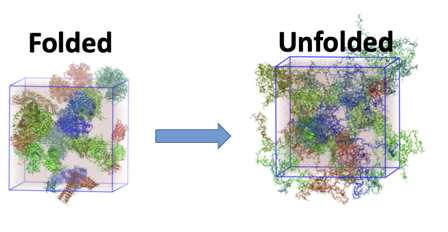- Share
- Share on Facebook
- Share on X
- Share on LinkedIn
Publication
On January 16, 2023

Organisms have adapted to thrive in a narrow, well-defined temperature range. Humans are comfortable in ambient conditions, but other organisms can withstand much higher temperatures, even above the boiling temperature of water. How temperature kills a cell is not completely understood, but it is crucial in many ways. For example, to understand how life evolved on our planet, and how it can potentially develop elsewhere. We also need to consider how even small changes in temperature in the environment due to climate issues can throw the current distribution of living organisms out of balance. Finally, how therapeutic approaches can be optimized to kill cancer cells by locally increasing the temperature of the cells.
To expand and simplify the story let’s use a metaphor. A cell looks like a factory where the proteins represent the laborious working-class. They transform energy and compounds, they provide mechanical force for motility, and stability; they decode the genetic information. When we increase slightly the temperature the efficiency of their activity increases. It is like a boost of energy. They have more “strength” and “energy” to accomplish the task. From the physical point of view, this is explained by what is known as Boltzmann factor. Temperature also influences another and subtle aspect, it increases the transport of matters inside the cell. However, when a critical temperature is reached, proteins get destabilised. The efficiency of the work is compromised. Back to the original question: at the critical temperature (known as cell death temperature) all the working class stops producing or just a bunch of workers, that control key positions in the productive chain, stop their activity?
We have recently looked at the issue (read the manuscript open access here: https://pubs.acs.org/doi/10.1021/acscentsci.2c01078), and found support to the idea that just a little amount of proteins actually unfolds and stops to be operative at the cell death temperature. In parallel, by melting the proteins alter the dynamical properties of the surrounding environment. The local viscosity dramatically increases. In some sense, according to our initial metaphor, it is like that by unfolding they slow down all the assembly-lines inside the factory. The molecular reason of this effect is not surprising at all. When a protein unfolds it becomes a floppy and long spaghetti that tends to glue the surrounding macromolecules and the environment starts looking like a gel. In short, not necessarily the few proteins that unfold must act as pivotal enzymes in critical metabolic patterns. Their unfolding might be enough for suppressing some metabolic reactions that are controlled by the local diffusivity. The question is open…..
More Info
Temperature and death cell : a story of viscosity (CNRS)
Date
Contact
Judith Peters
judith.peters univ-grenoble-alpes.fr (judith[dot]peters[at]univ-grenoble-alpes[dot]fr)
univ-grenoble-alpes.fr (judith[dot]peters[at]univ-grenoble-alpes[dot]fr)
Diffusive Dynamics of Bacterial Proteome as a Proxy of Cell Death
- Share
- Share on Facebook
- Share on X
- Share on LinkedIn